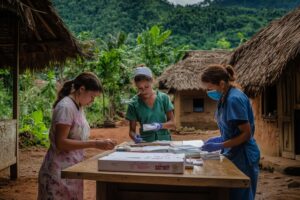Surgeries in the Jungle: The Portable Clinic in the Amazon
The vast expanse of nature leaves residents isolated, deprived of healthcare assistance. Change began to take shape through various tools, such as the portable operating room.

Amid the immense and dense Amazon rainforest, where geography itself imposes immense challenges, access to specialized medical services is limited or non-existent. Yet a portable clinic is transforming the lives of residents who have historically been cut off from essential services.
Surgeries that once required days of travel along rivers and impassable roads are now being performed in remote communities thanks to an innovative combination of medical technology, adapted logistics, and humanitarian commitment. Treatments for curable conditions are finally reaching local populations.
Medicine in the Heart of the Jungle
The Amazon spans more than 7 million square kilometers and is one of the richest and most complex ecosystems on the planet. But this extraordinary natural environment also represents isolation for many of the indigenous and rural communities that inhabit it.
In areas where the only access is by river and no nearby hospitals exist, health conditions considered treatable can become permanent disabilities or even cause death.
It is in this context of isolation that the initiative of creating a portable surgical clinic emerged. The project is carried out by interdisciplinary medical teams working alongside local communities to deliver both basic and specialized surgical care to the most inaccessible corners of the jungle.
The operation of this portable clinic is an example of logistical engineering and cultural and territorial adaptability. Surgeons, anesthesiologists, nurses, surgical technologists, and technicians travel in vessels specially adapted to navigate the Amazon’s rivers for weeks at a time until they reach their destination.
These barges serve both as transportation and as mobile surgical units. When conditions allow, procedures are carried out in schools or community halls temporarily converted into operating rooms.
In these spaces, portable surgical tables, electric generators, sterilization autoclaves, anesthesia equipment, and LED surgical lamps are set up. All equipment is transported in watertight cases designed to withstand the humid and rainy tropical climate.
The primary goal of these clinics is to address common surgical conditions that have long been neglected in the region. Inguinal hernias, lipomas, gallstones, cataracts, pterygium, and simple congenital malformations are among the most frequent procedures performed by these mobile operating rooms.
Beyond the procedures themselves, the key lies in the organization and prior coordination with community health agents. Weeks before the medical team’s arrival, they identify potential patients, manage preliminary diagnoses, and prepare the physical spaces.
During the missions, dozens of people are treated daily, prioritizing the most urgent cases or those affecting functionality and quality of life. Surgeries are free of charge and are followed by postoperative check-ups in the same community or through telemedicine whenever possible.
Intercultural Healthcare in the Amazon
Working in the jungle is not only a technical challenge; it also requires respect for the values of indigenous peoples. In many of these communities, traditional healing practices coexist with Western medicine. For this reason, interculturality is a cornerstone of the care model.
This approach not only facilitates the acceptance of surgeries but also strengthens trust with the community. Medical teams have integrated indigenous health promoters as interpreters and companions during surgical processes, thereby minimizing potential issues related to language and cultural differences.
Still, other challenges are inherent to the environment. Extreme weather conditions, lack of infrastructure, poor connectivity, and the difficulty of maintaining a continuous supply of medical resources are just some of them.
In addition, these projects often rely financially on private donations, international cooperation, and local governments, which are key to sustaining them. Guaranteeing postoperative follow-up also remains a major challenge, as it is crucial for detecting complications or infections after interventions.
Beyond Surgery: Building Capacity and Trust
For those who participate in these missions, the impact goes beyond the surgical act itself. Each mission strengthens social ties, trains local human resources, and leaves behind lasting capacities—such as community first-aid kits and knowledge of first aid and disease prevention.
The portable clinic model, in addition to showing remarkable results in the Amazon, has become an example. This type of work is now being replicated in other hard-to-reach rural areas, such as the Andean region and the Chaco, where primary healthcare services are being delivered.
However, its success depends entirely on the ability to combine high-quality medicine with a human approach that is culturally relevant and adapted to the territory. These initiatives and new experiences serve as living examples, providing lessons on how the right to health can be brought closer to those marginalized and far from major cities.


